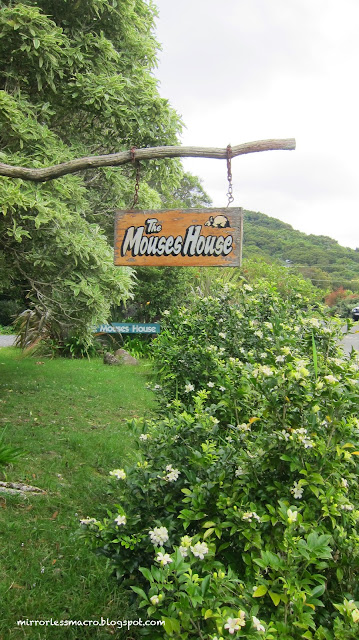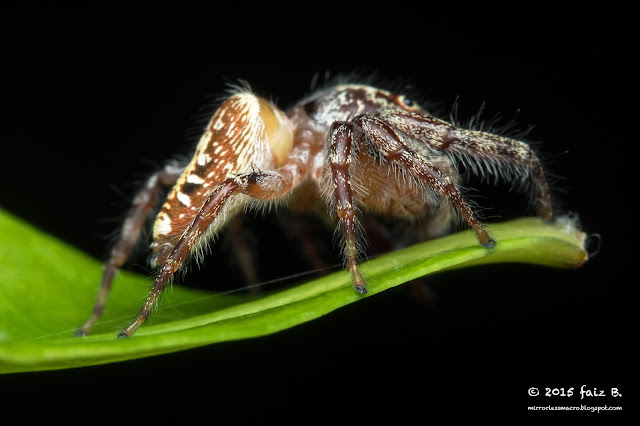Earlier this week, i visited Cameron Highlands with a friend, Kurt Orion, to sample the rich bio-diversity that the Malaysian State of Pahang has to offer. Cameron Highlands is one of the highest points in the country but despite its much lower temperature, it does produce an impressive list of reptiles, a group of animals that are usually synonymous with warmer climates.
I was initially looking to visit Fraser's Hill on my own to photograph some endemic spiders but since Kurt hasn't been to Cameron Highlands in a long time, I figured why not. Anyway, it is always good to have another pair of trained eyes like Kurt's. Kurt is from Kuala Lumpur (KL), a city halfway between Singapore (where I am from) and Cameron Highlands so the arrangement was for me to fly to KL and then hitch a ride the rest of the way from him. A few phone calls, 3 web-bookings and 2 days later, I found myself at the Kuala Lumpur International Airport, en-route to KL Sentral where Kurt was waiting for me.
When we finally met in KL Sentral, I was already feeling quite tired from pulling an all-nighter, 'geeking' through a list of reptiles and invertebrates that can be found in Cameron Highlands the night before. Since I had an early morning flight, I foolishly decided to skip sleeping altogether with hopes of catching some shuteye at the airport later. Nope, that sleep didn't happen. Thankfully, Kurt was kind enough to suggest that i get some sleep on the 5-hour drive up to Cameron Highlands.
We arrived and checked into our Resort located in Tanah Rata at about 4pm, and proceeded to charge our batteries, before finalising our plans for the next 2 days. There are about 10 jungle trails that were open to the public but we only had our eyes set on 4, based on recommendations from friends in the herping community. We chose to stay in Tanah Rata for the strategic reason that it was the town closest to all of our chosen trails. For those of you who are familiar with the place, you would know that some of the trail-heads are pretty much left unmarked and as a result, quite difficult to locate. I have read some articles online that the absence of these markings were the act of some irresponsible local guides who deliberately removed the signs to push for their own forest-guide services. For your own convenience and safety, I would highly recommend that you grab a copy of a Forest Trail Map which is available for purchase from various establishments throughout Tanah Ratah at RM1 to 4 per copy - Price varies, depending on where you choose to buy them from. Alternatively, you can always ask the locals and if they know, they would be more than happy to point you to the location of the popular Trail Heads.
Another word of advise when herping/hiking out here - make sure that you're properly attired, wearing the right type of shoes, and always carry spare batteries for your torchlights. Some of these trails are long and treacherous so you would not want to be stuck out here in the dark, especially if you're out alone. I mentioned about the importance of wearing the right shoes because for most parts of one trail in particular - the Robinson's Waterfall trail- you will be walking dangerously close to a cliff, so please be extra careful with your footings. Leeches and mosquitoes do not seem to be a problem at these higher altitudes, particularly true for the trails that we explored.
Over the span of the next 2 days, we managed to complete most of the 4 trails although only 2 yielded good finds. We tried our best to stick to the programme and not get too distracted with other non-reptile finds, although I must admit that it wasn't easy. Here are some highlights from our short expedition!
Believe it or not, we walked more than 7 hours on the first night before finally finding our first snake - get this - at the starting point of our trail while making on our way back to the car! Coincidentally, this species of slug snake was the first and last snake we found during the whole expedition.
Asthenodipsas cf. lasgalenesis can only be found in montane and submontane primary forests of Peninsular Malaysia and is said to be arboreal. True enough, as Kurt spotted one climbing a tree on our very last day.
There is another species of the same genus, A. vertebralis, which also occurs in highlands of Peninsular, but with a very distinct ventral banding. Unfortunately, we were unable to spot its terrestrial cousin.
As its name suggests, these snakes feed on slugs and snails. Not much else is known about this highly localised species.
Close-up of the iridescent scales.
A rare red mountain racer (Oreocryptophis porphyracea) - You would never have guessed where we found it! Only managed a single albeit blurry shot.
A magnificent blue-eyed Malayodracon robinsonii.
Up Close.
It ran up a tree, allowing us to get a clear dorsal shot.
I had to modify my flash set-up for this lower-magnification shot.
Another stunning montane species, the Bell's Angle-head lizard (Gonocephalus bellii). Look at the amazing colors on its dewlap!
I think I might have just awoken a sleeping dragon. Did my best to creep in closer for a head shot but was unsuccessful as it darted towards an adjacent tree and escaped under the thick foliage.
Found another sleeping beauty down the trail but this time i waited much longer before getting close.
My strategy worked but this was as close as i could get. Any closer and I am sure it would have darted off!
Sure enough.. i tried getting closer and it backed away. ID suggestions for this lizard would be appreciated!
As we were crossing a bridge, I looked down into the stream and spotted a familiar sight of a snake swimming. I signalled to Kurt who immediately jumped into the knee-deep water and safely brought it up on land.
Another rare find - a red mountain keel back (Hebius cf. sanguineum).
Very little is known about these water-loving snakes. They are highly elusive and have been observed to dive underwater to escape, making them incredibly hard to photograph.
One more shot before releasing back to where we found it.
I had no idea that it was there despite standing right in front of it. If Kurt had not suggested that I take a second look, I would probably would have walked right pass.
This is Xenophrys longipes, commonly known as the Long-legged Horned Frog. This species occurs only in higher elevations and is closely related to its much bigger cousin, the Malayan Horned Frog (Megophrys nasuta).
From this shot, you can clearly see how it got its common name - the Horns and powerful long legs!
This species is also said to occur in the montane areas of Southern Vietnam and Cambodia.
A closer look at the horns.
We spotted this cryptic-looking frog on a leaf, right next to a dangerously high cliff. I can't remember the ID that Kurt had suggested!
This frog got Kurt all excited. Apparently, he has never seen this species before. A quick check with some friends might suggest that this is a Philautus petersi. Apparently this species is quite new to science and there isn't a common name for it yet.
So yeah, that pretty much concludes the herping portion of the trip. Every other finds were non-reptiles (which isn't exactly a bad thing for me). We were initially quite bummed out by the apparent lack of reptiles sightings. And then there were those that escaped our camera lenses because they were either too fast or inaccessible. It sucks but that is the raw reality of field herping in an unfamiliar land. On the other hand, there were plenty of bugs, most of which I did not photograph in my attempt to stick to the 'programme'. Below are some of the spiders and insects that I could not bear to walk away without taking a few pictures.
This is my attempt at a rotisserie-style shot of a Big-Headed Bark Spider (Caerostris sp.). Looks different from the Lowland species.
It wraps around the branch and camouflages itself perfectly.
A dorsal shot of the Big-Headed Bark Spider. To learn more about other highly cryptic invertebrates, click here.
Another beautiful spider that we just had to stop and photograph. I didn't know just how colourful it was until I started taking close-up shots of it.
An amazing Sparassid with splashes of beautiful colours all over.
I tried a few backlighting shots with this newly emerged cicada. To learn more about backlighting techniques click here.
Another attempt at backlighting with this hairy moth caterpillar.
A close-up shot of its head with regular lighting.
Another perspective of this beautiful moth caterpillar which is approximately 3cm in length.
And of course, a dorsal shot.
I also tried my hands on some wide-angle macro shots with this Jungle Nymph (Heteropteryx cf. dilatata), a species of stick insect that we found near the Mossy Forest. To see more wide-angle macro shots taken with the mirrorless system, please click here.












































































































































































